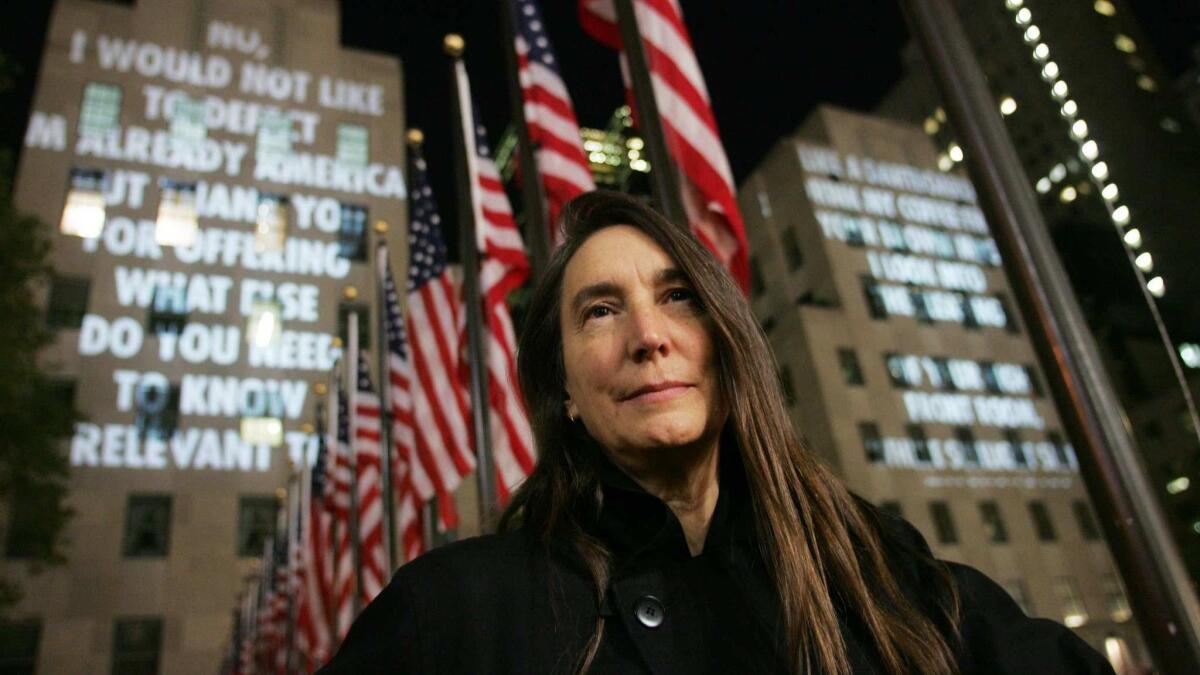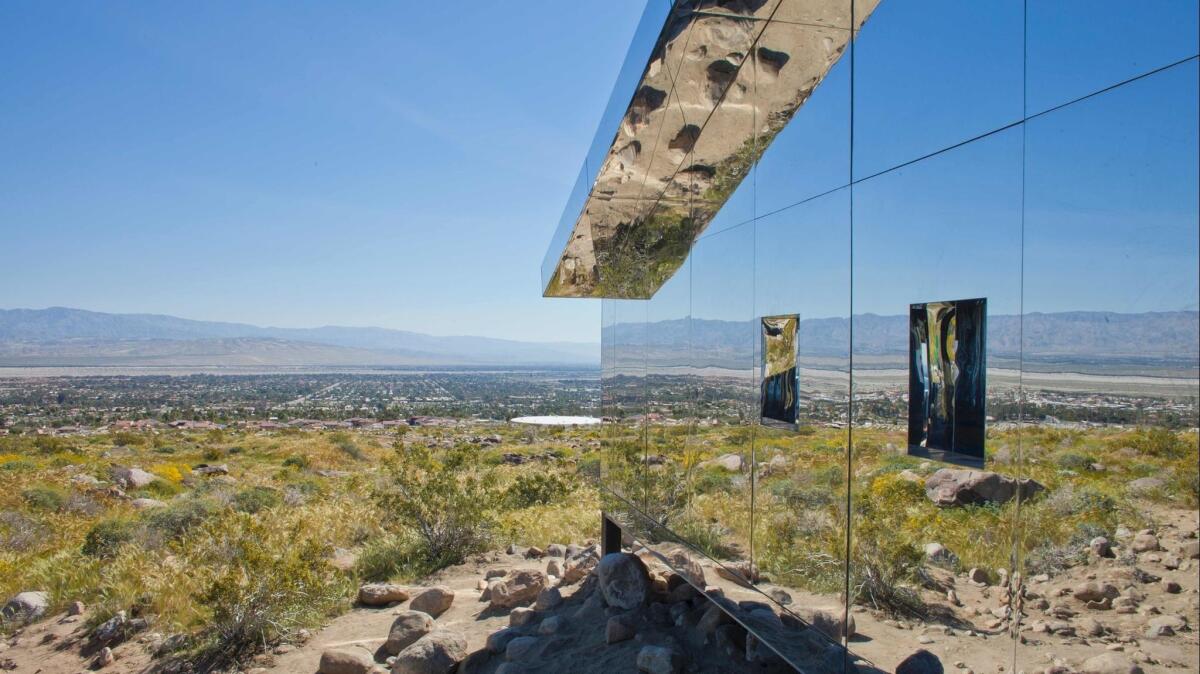Desert X art show puts a Jenny Holzer installation on hold over animal welfare worries
- Share via
The Desert X biennial that scatters large-scale artworks across the Coachella Valley will open Saturday minus one of its most anticipated pieces, a projection by Jenny Holzer that has been put on hold because of concerns about its effect on nearby bighorn sheep.
The New York artist had planned to project text from gun violence survivors, their family members and activists, as well as snippets of poetry, onto the face of a 50-foot-high stream bank at the Whitewater Preserve in the San Bernardino Mountains, a gateway to the Sand to Snow National Monument. But a pneumonia virus has killed at least 30 bighorn sheep in the area, and the Wildlands Conservancy, which owns and oversees the Whitewater Preserve, has withdrawn permission for Holzer’s project, titled “Before I Became Afraid, 2019.”
“They’re in a fragile, fragile state,” Wildlands Conservancy regional director Jack Thompson said of the sheep, who started dying in mid-November. “There’s potential, from what we’ve seen when the bighorn sheep are sick, for them to wander in places in proximity to people that they normally wouldn’t do because they’re ill. Their behavior is different.
“That combination of sick animals, light projections and large groups of people — it just seems insensitive and unpredictable. We’re not willing to risk the safety of the animals and the attendees.”
Thompson said he gave Desert X permission to use that particular site because the west side of the canyon, unlike the east, “had little vegetation and no sensitive animal habitat to speak of.” He said the Wildlands Conservancy believes it’s important for conservation organizations to collaborate with arts organizations in educating the public about the desert environment, which is partly why he greenlighted the Holzer project in December.
After more closely examining the sheep’s movement and noticing their proximity to the artwork’s site, Thompson said he reconsidered.
The decision surprised Desert X, Executive Director Jenny Gil said.
“We’re really concerned about the emergency with the bighorn sheep in the area and are respectful of Jack’s request not to hold the event there at this time,” Gil said. “But we’ve been working with Jack and the Wildlands Conservancy for months. Our plans were confirmed, and he’d confirmed the projections wouldn’t be harmful to the environment or wildlife.”

Holzer’s work was intended to be shown six times, 45 minutes each time, for an outdoor audience limited to 150 people. Now Desert X is considering new ways to show Holzer’s piece. In the past, Holzer has shown her work on advertising billboards, on the facade of the Solomon R. Guggenheim Museum in New York, as well as on LED screens mounted to trucks and buses, among other places.
Holzer hopes the project will be realized before Desert X ends April 21, “so that the writers’ important text can be seen, felt and echoed,” she said via email.
Ironically, environmental concerns are a theme in this year’s Desert X. Seven of 19 works — many clustered around the Salton Sea — address such issues.
Artists Chris Taylor and Steve Badgett created a solar-powered marine science lab, “Terminal Lake Exploration Platform,” that will explore the Salton Sea. Egypt-born, Berlin-based artist Iman Issa’s installation “Surrogates” addresses oil refineries, mineral extractions and the exploitation of natural resources. The Danish collective Superflex is debuting a giant, pink aluminum structure that will call attention to rising sea levels.
In 2017 the inaugural edition of Desert X drew more than 200,000 people in nine weeks, organizers said. Visitors took free, self-guided tours of 16 artworks scattered across 45 miles in the Coachella Valley. Some locals complained about traffic, congestion, noise and litter, especially in remote hiking areas.
“For people who’ve lived here for a long time, it’s a nightmare,” said Ann Japenga, who has lived in Palm Springs for 25 years (and is a former L.A. Times staffer). “It’s like invaders. They run roughshod over the landscape in the name of art.”

In 2017 neighbors of Doug Aitken’s “Mirage” — a ranch house in Palm Springs fully mirrored on the outside and inside — complained about noise, visitors parking outside their homes and driveways being blocked.
Others complained about Berlin-based artist Claudia Comte’s “Curves and Zigzags,” an Op Art mural more than 110 feet long in Palm Desert. The work was adjacent to a trail head that’s an entry to the Santa Rosa-San Jacinto National Monument, where people go to escape the stresses of everyday life and find peace in nature, said Ruth Nolan, a desert scholar and professor at the College of the Desert who has lived in Palm Desert for 20 years.
“For those of us who live here and care about our region, we’re already overwhelmed with record numbers of visitors,” Nolan said. “Our hiking areas and preserves here are overwhelmed and it’s stressful that an organization like Desert X would be doing something on such a large scale.”
Desert X and Holzer originally worked with the city of La Quinta to show the artwork at La Quinta Cove, a neighborhood surrounded on three sides by mountains. But after the city experienced traffic problems during its Dec. 9 Ironman Triathlon, the city council had a change of heart.
“We couldn’t put a traffic plan in place, in the period of time we had left, that would handle the influx they were anticipating for Desert X,” said La Quinta City Manager Frank Spevacek.
After Desert X 2017, the Mojave Desert Land Trust worked with the high desert arts community to publish online best practices for artists producing public works in the desert. The document addresses securing permits, parking, trash removal, noise management and light pollution, among other topics.
“I think it’s a very useful tool the artists could easily adopt and make use of,” land trust outreach director Michael Mora said. “What’s really important is they incorporate these best practices, this awareness of the landscape, at the conceiving of their projects.”
Gil said Desert X has a “leave no trace” policy at its sites. “We have budgets to restore the sites after the exhibits close,” she said.
“We’ve learned a lot from the first year’s experience. No one expected so many people to come out and see the artworks. We have different parking plans, waste management and crowd control that we’ve worked out with the different cities and sites.”
The board of the nonprofit group includes artist Ed Ruscha, collector Beth Rudin DeWoody and former Palm Springs Art Museum Director Steven A. Nash. Most of the organization’s funding comes from donations and grants. According to tax filings, Desert X brought in $889,658 for the 2016-2017 fiscal year.
Founding artistic director Neville Wakefield is joined this year by co-curators Amanda Hunt, the Museum of Contemporary Art’s director of education and public programs, and Matthew Schum, an independent curator based in Los Angeles.
Wildlife experts are investigating the sheep virus but haven’t determined its cause. Thompson isn’t hopeful it will be resolved before April 21, when Desert X ends.
Follow me on Twitter: @debvankin
More to Read
The biggest entertainment stories
Get our big stories about Hollywood, film, television, music, arts, culture and more right in your inbox as soon as they publish.
You may occasionally receive promotional content from the Los Angeles Times.











